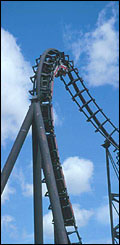Roller Coasters

From the Russian countryside to Disneyland
by Marcus McGraw and Catherine McNiff |
 Editor's PicksAlpengeist Busch Gardens, Williamsburg, VA Riddler's Revenge Millennium Force Banshee New England Skyscreamer |
Way back in the 18th century Russia's Catherine the Great was sitting around one summer wishing it were cold. She missed those days when Slavs could hop into small carts and ride down a 70-foot hill of ice. What was an empress to do when the snow melted? After much thought she had an answer: add wheels.
Fast forward to the heat of today. Somewhere out there people are waiting to ride the descendants of Catherine's coasters. But now those wooden carts are made of steel and carry names like Goliath, Millennium Force, and Alpengeist. People still seek speed but also modern thrills like loops, turns, and drops that make them question that chili dog/cotton candy lunch combo.
Indeed, summer is here and so is the desire for roller coaster rides. From Disneyland to Disneyworld, people are screaming through the loops of old favorites and dropping fast from the even higher hills. In recent years, park owners have spent up to $15 million on new roller coasters that boast the titles of biggest, longest, or fastest.
Coney Island
In 1884 preacher LaMarcus A. Thompson decided to build a new ride at New York's Coney Island to divert attention from the local beer gardens. He built two parallel tracks, with individual cars that climbed 15 feet and zoomed by at 4 miles per hour.
The plan worked. People swarmed to Coney Island to both ride and watch Thompson's "inclined-plane railway." Charging a nickel a ride, Thompson paid for the entire project in just three weeks. And by 1888 he had built nearly 50 roller coasters in the United States and Europe.
The summer of 2015 saw the rise of a new giga-coaster—breaking the 300 ft horizontal barrier—the Fury 325 in Charlotte, N.C. Ranking in the top five worldwide for height and clocking in at 95 mph, this is a ride thrill seekers will remember.
The Feel of the Industrial Revolution
"Thompson recognized and exploited all the ingredients of a successful amusement ride," writes Judith A. Adams in The American Amusement Park Industry. "His coasters combined an appearance of danger with actual safety, thrilled riders with exhilarating speed, and allowed the public to intimately experience the Industrial Revolution's new technologies of gears, steel, and dazzling electric lights."
Thompson's ride also caught the attention of other entrepreneurs. To draw crowds they advertised improvements like larger hills, chain lifts, and oval tracks. By 1900 there were hundreds of roller coasters across the country.
The roller coaster continued to flourish through the 1920s. As speeds increased so did the need for safety features like under-track wheels, lap bars, and "no standing" signs. But the Great Depression and World War II diverted the public's attention from amusement parks. Money for entertainment was scarce, and wood and rubber were needed for the war effort.
The Real Coaster Boom
Unlike its cousin the carousel, the roller coaster experienced a rebirth when Walt Disney opened the nation's first theme park, Disneyland. In addition to increased speed and new heights, Disney's roller coaster provided a smooth ride using a new tubular steel. It attracted entire families, not just eccentric thrill seekers. Other theme parks would follow Disney's lead, each including new rides with broad appeal. And by the 1970s a "coaster boom" was underway as teams of engineers designed and constructed new rides.
Roller Coaster Safety
For all their "no guts no glory" hype and glamour, how safe are roller coasters? According to the International Association of Amusement Parks and Attractions (IAAPA), very. The IAAPA claims a 1 in 24 million chance of suffering serious injury from riding amusement park rides. Roller coasters in particular cause the second most injuries, after "family and adult rides." According the the self-reported statistics presented by the IAAPA (and updated in 2016), there were 670 (58%) injuries on family and adult rides, 383 (33.4%) on roller coasters, and 94 (8.2%) on children's rides in 2013. But, considering the lack of consistent state or federal oversight, it is up to you to make the final decision to thrill or chill, and if riding, make sure to follow the correct safety precautions.
For more amusement park statistics, see our Amusement Ride Injuries table.
